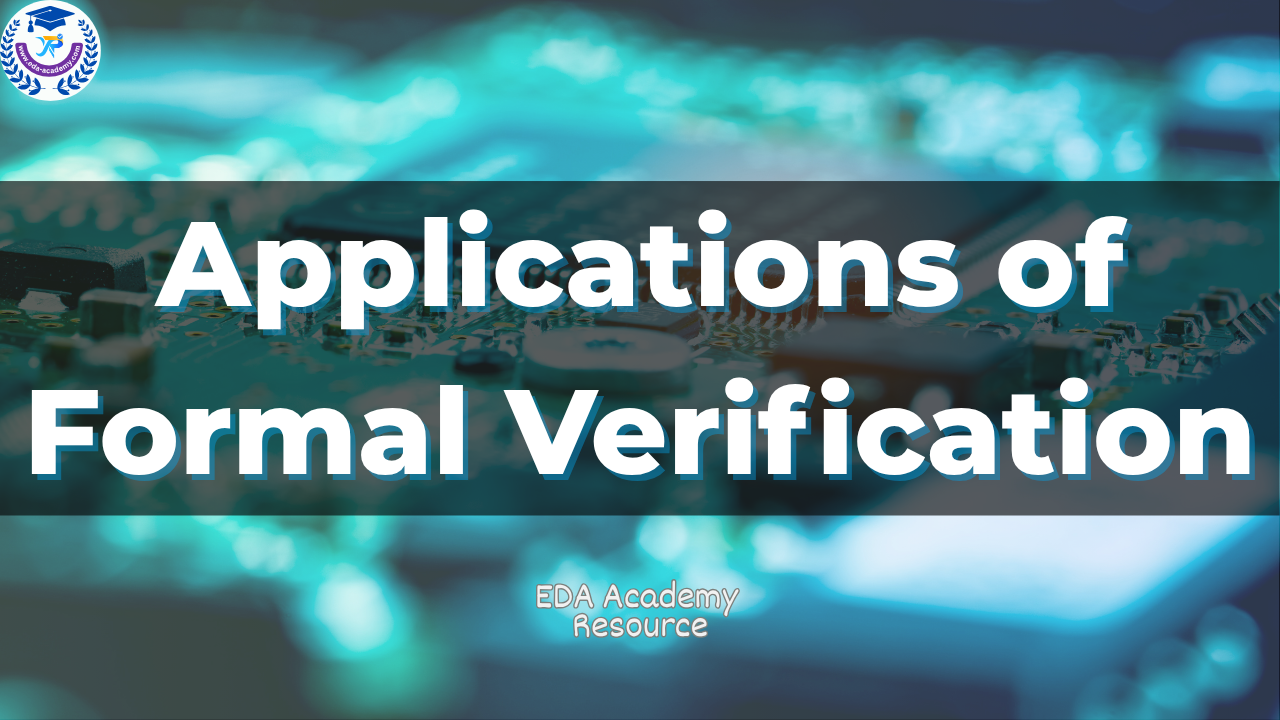Resource:
Applications of Formal Verification (English)
Formal verification applies mathematical analysis to exhaustively prove hardware design properties without the need for simulation vectors. Smart formal applications encapsulate targeted verification objectives into automated flows, improving productivity and scalability. Automatic checks catch deadlocks, livelocks, and unreachable code. Clock domain crossing verification ensures safe synchronization between asynchronous domains. X-propagation checks highlight hazards from undefined states. Sequential equivalency checking confirms RTL consistency. Additional apps cover safety fault injection, security access control, property synthesis, datapath verification, hierarchical connectivity, and register implementation validation. These tools accelerate sign-off by providing reusable, high-precision solutions for critical functional and structural issues.
Purchase
Our course syllabus is regularly updated to reflect the latest advancements and best practices in the field. For individually purchased courses or resources with lifetime access, students can always access the content and receive updates for free. For members, all member-free courses and resources — including future updates — are accessible during the active subscription period. This ensures that both lifetime purchasers and active members can benefit from the most relevant and up-to-date content.
Created by EDA Academy
English
Last updated July 2025

Resource: Applications of Formal Verification (English)
USD $199.9
-55%Today
$89.9
One-time Purchase
& Lifetime Access
What you will get:
1.2 Hours of Immersive, High-Quality Video Lessons
Professionally produced and delivered by our expert team, covering core concepts and practical demonstrations, with step-by-step explanations and real-life examples to help you efficiently absorb knowledge and apply it immediately in a short time.
Certificate of completion
Upon successful completion of the course, you will receive an official certificate issued by EDA Academy, adding value to your resume and career development.
Access on mobile and computer
The course can be viewed anytime on mobile phones, tablets, and computers, allowing you to learn easily whether at the office, at home, or on the go.
Ongoing support from EDA Academy
After the course ends, you will continue to receive ongoing support from our team to help you consolidate knowledge and solve practical problems.
Further learning plan
Provides you with follow-up learning paths and recommended resources, enabling you to continue improving your skills and expanding your career development based on what you have learned.
Resource Catalogue
Description
Formal verification is a static, exhaustive methodology that enables mathematical reasoning over all possible input scenarios, making it ideal for finding corner-case bugs and proving correctness in areas where simulation may fall short. Smart formal applications distill this power into modular verification units, each tailored to a specific task and integrated into automated workflows. These apps do not rely on hand-written assertions; instead, they use configuration files, design constraints, and protocol specifications to drive verification tasks with minimal setup and consistent results.
Automatic formal checks serve as the foundation for general-purpose formal verification. These checks are used to detect common design problems such as deadlocks, livelocks, design state that can never be reached, unintended data paths, and incorrect resets. Because they are push-button in nature and require minimal customization, they are often deployed early in the design cycle for immediate feedback. These checks offer rapid coverage of structural and control integrity, catching bugs that would otherwise require complex simulation testbenches.
Clock domain crossing (CDC) verification is another key application. Asynchronous communication between different clock domains can cause metastability or data corruption if not handled correctly. Formal CDC apps analyze the synchronization structures and handshake protocols across domains, verifying safe data transfer mechanisms. This includes checking for missing synchronizers, improper data sampling, and reset domain mismatches. By modeling timing-agnostic scenarios symbolically, formal CDC tools ensure robustness regardless of frequency ratios or real-world operating conditions.
X-propagation checking uses formal engines to identify uninitialized, undefined, or unknown values that may propagate through logic and lead to erratic or invalid design behavior. These checks are essential for identifying simulation mismatches, where X states might be masked but can cause issues in actual hardware. The formal approach allows tracing all possible sources and destinations of Xs, offering better diagnostic feedback than simulation-based X-analysis.
Sequential equivalency checking (SEC) provides functional comparison between two RTL implementations—commonly between an untimed algorithmic version and its pipelined or optimized counterpart. By verifying cycle-by-cycle equivalence under sequential transformations, SEC confirms that design intent remains unchanged through optimization. This is particularly useful in datapath-intensive blocks, where pipeline balancing or retiming must not alter functionality. Unlike combinational equivalence, SEC handles state elements and clocking explicitly, enabling full confidence in implementation correctness.
Further smart apps support deeper design validation. Code unreachability analysis flags dormant or unused logic, helping to optimize and clean the RTL. Safety fault analysis injects stuck-at or transient faults into the design and verifies fault propagation to safety monitors, supporting ISO 26262 and other functional safety standards. Security verification confirms that protected regions are not accessible under illegal scenarios, ensuring isolation between domains. Property synthesis auto-generates assertions from RTL control logic, accelerating formal testbench development. Datapath verification targets arithmetic structures such as multipliers, dividers, and accumulators using mathematical models. Connectivity checking ensures signals and buses are wired correctly across modules and layers. Register checking validates that control/status registers follow specification for accessibility, reset behavior, and field-level access.
Each formal app provides focused analysis for a critical verification concern, delivering results faster and more thoroughly than general simulation. Together, they form a comprehensive suite of scalable, reusable, and high-precision solutions essential to modern digital design flows. These tools enhance design quality, accelerate sign-off, and support compliance with functional safety and security standards across ASIC, SoC, and FPGA projects.
We HATE spam. Your email address is 100% secure
The document will be emailed to you. Please check your Spam folder if it doesn’t appear in your inbox.
We HATE spam. Your email address is 100% secure
